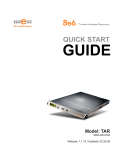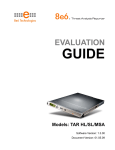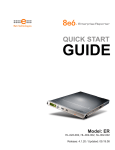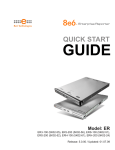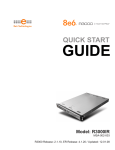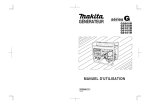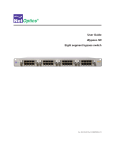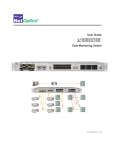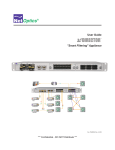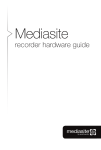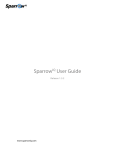Download 8e6 Technologies Threat Analysis Reporter TAR User's Manual
Transcript
® Threat Analysis Reporter QUICK START GUIDE Model: TAR HL-005-004, SL-004-004, MSA-004-004 Release: 1.2.00 / Updated: 09.19.08 8e6 Threat Analysis Reporter Quick Start Guide © 2008 8e6 Technologies. All rights reserved. This document may not, in whole or in part, be copied, photocopied, reproduced, translated, or reduced to any electronic medium or machine readable form without prior written consent from 8e6 Technologies. Every effort has been made to ensure the accuracy of this document. However, 8e6 Technologies makes no warranties with respect to this documentation and disclaims any implied warranties of merchantability and fitness for a particular purpose. 8e6 Technologies shall not be liable for any error or for incidental or consequential damages in connection with the furnishing, performance, or use of this manual or the examples herein. The information in this documentation is subject to change without notice. The Threat Analysis Reporter products have been tested and found to comply with the limits for a Class A digital device, pursuant to part 15 of the FCC Rules. These limits are designed to provide reasonable protection against harmful interference when the equipment is operated in a commercial environment. This equipment generates, uses, and can radiate radio frequency energy and, if not installed and used in accordance with the instruction manual, may cause harmful interference to radio communications. Operation of this equipment in a residential area is likely to cause harmful interference in which case the user will be required to correct the interference at his own expense. Trademarks Other product names mentioned in this manual may be trademarks or registered trademarks of their respective companies and are the sole property of their respective manufacturers. Part# TARul-QSG-080919 ii 8e6 Threat Analysis Reporter Quick Start Guide Contents Threat Analysis Reporter Introduction. ...................................................1 About this Document..................................................................................................................... 2 Conventions Used in this Document............................................................................................ 2 Service Information...................................................................................3 Preliminary Setup Procedures..................................................................4 Unpack the Unit from the Carton.................................................................................................. 4 Select a Site for the Server............................................................................................................ 5 Rack Mount the Server................................................................................................................... 6 Check the Power Supply.............................................................................................................. 23 General Safety Information.......................................................................................................... 24 Install the Server...................................................................................27 Step 1: Initial Setup Procedures................................................................................................. 27 Step 1A: Quick Start Setup Procedures..................................................................................... 28 Step 1B: LCD Panel Setup Procedures...................................................................................... 44 Step 2: Wizard Setup Procedures............................................................................................... 50 Conclusion..............................................................................................59 LED Indicators and Buttons...................................................................60 SL and MSA Units......................................................................................................................... 60 HL Unit . ........................................................................................................................................ 61 HL and SL Units............................................................................................................................ 63 Regulatory Specifications and Disclaimers.............................................64 Declaration of the Manufacturer or Importer............................................................................. 64 Appendix: Optional Ethernet Tap Installation. .......................................67 Preliminary Setup Procedures.................................................................................................... 67 Install the Ethernet Tap Unit........................................................................................................ 68 Index........................................................................................................70 8e6 Threat Analysis Reporter Quick Start Guide iii iv 8e6 Threat Analysis Reporter Quick Start Guide Threat Analysis Reporter Introduction Thank you for choosing to evaluate the 8e6 Technologies Threat Analysis Reporter. This product addresses user-generated Web threats such as excessive use of bandwidth and inappropriate Internet usage, and provides network administrators tools to monitor such threats so management can enforce corporate Internet usage policies. Working in conjunction with 8e6’s R3000 Enterprise Filter, the Threat Analysis Reporter translates end user Internet activity from the R3000’s logs into dynamic graphical snapshots of network Internet traffic. Using remediation tools in the console, administrators and management can then manage and control user-generated Web threats in real time. The TAR HL and SL server models include RAID technology for fault tolerance and high performance. 8e6 Threat Analysis Reporter Quick Start Guide About this Document This document is divided into the following sections: • Introduction - This section is comprised of an overview of the Threat Analysis Reporter product and how to use this document • Service Information - This section provides 8e6 Technologies contact information • Preliminary Setup Procedures - This section includes instructions on how to physically set up the Threat Analysis Reporter unit in your network environment • Install the Server - This section explains how to configure the Threat Analysis Reporter • Conclusion - This section indicates that the quick start steps have been completed • LED Indicators and Buttons - This section explains how to read LED indicators and use LED buttons for troubleshooting the unit • Regulatory Specifications and Disclaimers - This section cites safety and emissions compliance information for the TAR models referenced in this document • Appendix: Optional Ethernet Tap Installation - This appendix explains how to install the optional Ethernet Tap device on your network for bandwidth monitoring • Index - An alphabetized list of some topics included in this document Conventions Used in this Document The following icons are used throughout this document to call attention to important information pertaining to handling, operation, and maintenance of the server; safety and preservation of the equipment, and personal safety: NOTE: The “note” icon is followed by additional information to be considered. WARNING: The “warning” icon is followed by information alerting you to a potential situation that may cause damage to property or equipment. CAUTION: The “caution” icon is followed by information warning you that a situation has the potential to cause bodily harm or death. 8e6 Threat Analysis Reporter Quick Start Guide Service Information The user should not attempt any maintenance or service on the unit beyond the procedures outlined in this document. Any initial hardware setup problem that cannot be resolved at your internal organization should be referred to an 8e6 Technologies solutions engineer or technical support representative. 8e6 Corporate Headquarters (USA) Local Domestic US International : 714.282.6111 : 1.888.786.7999 : +1.714.282.6111 8e6 Taiwan Taipei Local : 2397-0300 Domestic Taiwan : 02-2397-0300 International : 886-2-2397-0300 Procedures When calling 8e6 Technologies regarding a problem, please provide the representative the following information: • Your contact information. • Serial number or original order number. • Description of the problem. • Network environment in which the unit is used. • State of the unit before the problem occurred. • Frequency and repeatability of the problem. • Can the product continue to operate with this problem? • Can you identify anything that may have caused the problem? 8e6 Threat Analysis Reporter Quick Start Guide Preliminary Setup Procedures Unpack the Unit from the Carton Inspect the packaging container for evidence of mishandling during transit. If the packaging container is damaged, photograph it for reference. Carefully unpack the unit from the carton and verify that all accessories are included. Save all packing materials in the event that the unit needs to be returned to 8e6 Technologies. The carton should contain the following items: • • • • • • • 1 Threat Analysis Reporter unit 1 AC Power Cord, 2 AC Power Cords for HL servers 1 Serial Port Cable 1 CAT-5E Crossover Cable Rack Mount Brackets (2) 1 End User License Agreement (EULA) 1 envelope containing a CD-ROM with a PDF of the Threat Analysis Reporter User Guide. The latest version of the user guide can be obtained from our Web site at http://www.8e6.com/docs/tar_ug.pdf. NOTES: A coupler is included in the carton if a three-foot CAT-5E crossover cable is packaged with your unit instead of a 14-foot CAT-5E crossover cable. For HL and SL servers, 1 bezel to be installed on the front of the chassis also is included, as well as 1 spare parts kit. For HL servers, this kit contains a hard drive and power supply. For SL servers, this kit contains a hard drive. Inspect the server and accessories for damage. If the contents appear damaged, file a damage claim with the carrier immediately. WARNING: To avoid danger of suffocation, do not leave plastic bags used for packaging the server or any of its components in places where children or infants may play with them. 8e6 Threat Analysis Reporter Quick Start Guide Select a Site for the Server The server operates reliably within normal office environmental limits. Select a site that meets the following criteria: • Clean and relatively free of excess dust. • Well-ventilated and away from sources of heat, with the ventilating openings on the server kept free of obstructions. • Away from sources of vibration or physical shock. • Isolated from strong electromagnetic fields and noise caused by electrical devices such as elevators, copy machines, air conditioners, large fans, large electric motors, radio and TV transmitters, and high-frequency security devices. • Access space provided so the server power cord can be unplugged from the power supply or the wall outlet—this is the only way to remove the AC power cord from the server. • Clearance provided for cooling and airflow: Approximately 30 inches (76.2 cm) in the back and 25 inches (63.5 cm) in the front. • Located near a properly earthed, grounded, power outlet. 8e6 Threat Analysis Reporter Quick Start Guide Rack Mount the Server Rack Setup Precautions Warning: Before rack mounting the server, the physical environment should be set up to safely accommodate the server. Be sure that: • The weight of all units in the rack is evenly distributed. Mounting of the equipment in the rack should be such that a hazardous condition is not achieved due to uneven mechanical loading. • The rack will not tip over when the server is mounted, even when the unit is fully extended from the rack. • For a single rack installation, stabilizers are attached to the rack. • For multiple rack installations, racks are coupled together. • Reliable earthing of rack-mounted equipment is maintained at all times. Particular attention should be given to supply connections other than direct connections to the branch circuit (e.g. use of power strips). • A power cord will be long enough to fit into the server when properly mounted in the rack and will be able to supply power to the unit. • The connection of the server to the power supply will not overload any circuits. Consideration should be given to the connection of the equipment to the supply circuit and the effect that overloading of the circuits might have on overcurrent protection and supply wiring. Appropriate consideration of equipment nameplate ratings should be used when addressing this concern. • The server is only connected to a properly rated supply circuit. Reliable earthing (grounding) of rack-mounted equipment should be maintained. • The air flow through the server’s fan or vents is not restricted. Installation of the equipment in a rack should be such that the amount of air flow required for safe operation of the equipment is not compromised. • The maximum operating ambient temperature does not exceed 104°F (40°C). If installed in a closed or multi-unit rack assembly, the operating ambient temperature of the rack environment may be greater than room ambient. Therefore, consideration should be given to installing the equipment in an environment compatible with the maximum ambient temperature (Tma) specified by the manufacturer. WARNING: Extend only one component at a time. Extending two or more components simultaneously may cause the rack to become unstable. 8e6 Threat Analysis Reporter Quick Start Guide Rack Mount Instructions for HL Servers Rack Setup Suggestions • • Determine the placement of each component in the rack before you install the rails. Install the heaviest server components on the bottom of the rack first, and then work up. Identify the Sections of the Rack Rails You should have received two rack rail assemblies with the 8e6 server unit. Each of these assemblies consists of two sections: An inner fixed chassis rail that secures to the unit (A), and an outer fixed rack rail that secures directly to the rack itself (B). Two pairs of short brackets to be used on the front side of the outer rails are also included. Install the Inner Rails Both the left and right side inner rails have been pre-attached to the chassis. Proceed to the next step. Install the Outer Rails Begin by measuring the distance from the front rail to the rear rail of the rack. Attach a short bracket to the front side of the right outer rail and a long bracket to the rear side of the right outer rail. Adjust both the short and long brackets to the proper distance so that the rail can fit snugly into the rack. Secure the short bracket to the front side of the outer rail with two M4 screws and the long bracket to the rear side of the outer rail with three M4 screws. Repeat these steps for the left outer rail. 8e6 Threat Analysis Reporter Quick Start Guide Locking Tabs: Both chassis rails have a locking tab, which serves two functions. The first is to lock the server into place when installed and pushed fully into the rack, which is its normal position. Secondly, these tabs also lock the server in place when fully extended from the rack. This prevents the server from coming completely out of the rack when you pull it out for servicing. 8e6 Threat Analysis Reporter Quick Start Guide Install the Server into the Rack You should now have rails attached to both the chassis and the rack unit. The next step is to install the server chassis into the rack. Do this by lining up the rear of the chassis rails with the front of the rack rails. Slide the chassis rails into the rack rails, keeping the pressure even on both sides (you may have to depress the locking tabs when inserting). When the server has been pushed completely into the rack, you should hear the locking tabs “click.” 8e6 Threat Analysis Reporter Quick Start Guide Install the Server into a Telco Rack If you are installing the 8e6 server unit into a Telco type rack, use two L-shaped brackets on either side of the chassis (four total). First, determine how far follow the server will extend out the front of the rack. A larger chassis should be positioned to balance the weight between front and back. If a bezel is included on your server, remove it. Then attach the two front brackets to each side of the chassis, then the two rear brackets positioned with just enough space to accommodate the width of the telco rack. Finish by sliding the chassis into the rack and tightening the brackets to the rack. 10 8e6 Threat Analysis Reporter Quick Start Guide Rack Mount Instructions for SL Servers Rack Setup Suggestions • • Determine the placement of each component in the rack before you install the rails. Install the heaviest server components on the bottom of the rack first, and then work up. Install the Inner Slides 1. Locate the right inner slide, (the slide that will be used on the right side of chassis when facing the front panel of the chassis). 2. Align the four (4) square holes on the right inner slide against the hooks on the right side of the chassis as show below on the left. 3. Securely attach the slide to the chassis with two M4 flat head screws and repeat the steps 1-3 to install the left inner slide to the left side of the chassis. Install the Outer Slides 1. Measure the distance from the front rail of the rack to the rear rail of the rack. 2. Attach a short bracket to the rear side of the right outer slide, and a long bracket to the front side of the right outer slide as shown above on the right. 3. Adjust the short and long brackets to the proper distance so that the chassis can snugly fit into the rack. 4. Secure the slides to the cabinet with screws. 5. Repeat steps 1-4 for the left outer slide. 8e6 Threat Analysis Reporter Quick Start Guide 11 Install the Slide Assemblies to the Rack 1. After you have installed the short and long brackets to the outer slides, you are ready to install the whole slide assemblies (outer slides with short and long brackets attached) to the rack. (See the previous page.) 2. Use M5 screws and washers to secure the slide assemblies into the rack as shown below: 12 8e6 Threat Analysis Reporter Quick Start Guide Install the Chassis into the Rack 1. Push the inner slides, which are attached to the chassis, into the grooves of the outer slide assemblies that are installed in the rack as shown below: 2. Push the chassis all the way to the back of the outer slide assemblies as shown below: 8e6 Threat Analysis Reporter Quick Start Guide 13 Rack Mount Instructions for MSA Servers Optional: Install the Chassis Rails NOTE: If your chassis does not come with chassis rails, please follow the procedure listed on the last page of this sub-section to install the unit directly into the rack. CAUTION: Please make sure that the chassis covers and chassis rails are installed on the chassis before you install the chassis into the rack. To avoid personal injury and property damage, please carefully follow all the safety steps listed below: Before installing the chassis rails: • Close the chassis using the chassis cover. • Unplug the AC power cord(s). • Remove all external devices and connectors. 1. Included in the shipping package are a pair of rail assemblies. In each rail assembly, locate the inner rail and the outer rail. 2. Press the locking tab to release the inner rail from its locking position and pull out the inner rail from the rail assembly. NOTE: The inner rails are to be attached to the chassis and the outer rails are to be installed in the rack. 14 8e6 Threat Analysis Reporter Quick Start Guide 3. Locate the three holes on each side of the chassis and locate the three corresponding holes on each of the inner rail. 4. Attach an inner rail to each side of the chassis and secure the inner rail to the chassis by inserting three Type G screws through the holes on each side of the chassis and the inner rail. (See the diagram below for a description of the Type G screw.) 5. Repeat the above steps to install the other rail on the chassis. 8e6 Threat Analysis Reporter Quick Start Guide 15 Optional: Install the Traditional UP Racks After you have installed the inner rails on the chassis, you are ready to install the outer rails of rail assemblies to the rack. NOTE: The rails are designed to fit in the racks with the depth of 28” to 33”. • Determine the placement of each component in the rack before you install the rails. • Install the heaviest server components on the bottom of the rack first, and then work up. 1. In the package, locate a pair of front (short) and rear (long) brackets. Please note that the brackets are marked with Up/Front Arrows (front) and Up/Rear arrows (rear). 2. Secure the front (short) bracket (marked with the Up/Front arrows) to the outer rail with two Type G screws. (See the previous page for a description of the Type G screw.) 3. Attach the rear (long) bracket to the other end of the outer rail and secure the rear (long) bracket to the outer rail with a Type G screw as shown below. 4. Measure the depth of your rack and adjust the length of the rails accordingly. 5. Repeat the same steps to install the other outer rail on the chassis. 6. Secure both outer rail assemblies to the rack with Type H screws and Type I washers. (See the previous page for descriptions of Type H and Type I hardware components.) 16 8e6 Threat Analysis Reporter Quick Start Guide 7. Slide the chassis into the rack as shown below. NOTE: The chassis may not slide into the rack smoothly or easily when installed the first time. Some adjustment to the slide assemblies might be needed for easy installation. 8. You will need to release the safety taps on both sides of the chassis in order to completely remove the chassis out of the rack. 8e6 Threat Analysis Reporter Quick Start Guide 17 Optional: Install the Open Racks After you have installed the inner rails on the chassis, you are ready to install the outer rails of rail assemblies to the rack. NOTE: The rails are designed to fit in the racks with the depth of 28” to 33”. • Determine the placement of each component in the rack before you install the • rails. Install the heaviest server components on the bottom of the rack first, and then work up. 1. In the package, locate a pair of front (short) and rear (long) brackets. Please note that the brackets are marked with Up/Front Arrows (front) and Up/Rear arrows (rear). 2. Secure the front (short) bracket (marked with the Up/Front arrows) to the outer rail with two Type G screws as shown below. 18 8e6 Threat Analysis Reporter Quick Start Guide 3. Attach the front (short) bracket to the front end of the rack, and secure it to the rack with two Type H screws and Type I washers as shown below. (See the previous page for descriptions of Type H and Type I hardware components.) 4. Attach the rear (long) bracket to the rear end of the rack, and secure it to the rack with two Type H screws and Type I washers as shown below. Repeat the same steps to install the other outer rail to the other side of rack. 8e6 Threat Analysis Reporter Quick Start Guide 19 5. Measure the depth of your rack and adjust the length of the rails accordingly. Then, secure the rails to the chassis with Type G screws. 6. Slide the inner rails which are attached to the chassis into the outer rails on the rack. 20 8e6 Threat Analysis Reporter Quick Start Guide Install the Chassis into the Rack CAUTION: Before installing the chassis into the rack: • • • • • • Make sure that the rack is securely anchored onto an unmovable surface or structure before installing the chassis into the rack. Unplug power cord(s) of the rack before installing the chassis into the rack. Make sure that the system is adequately supported. Make sure that all the components are securely fastened to the chassis to prevent components falling off from the chassis. The rack assembly should be properly grounded to avoid electric shock. The rack assembly must provide sufficient airflow to the chassis for proper cooling. Please make sure that all components and all chassis covers are properly installed in the chassis before you install the chassis into the racks; otherwise, out-of-warranty damage may occur. Slide the chassis into the rack and secure it with two screws on each side of the rack as shown in the picture. 8e6 Threat Analysis Reporter Quick Start Guide 21 Install the SL or HL Server Bezel After rack mounting an SL or HL server, the bezel should be installed on the front end of the chassis. NOTE: This portion of the installation process requires you to unpack the bezel. The bezel has been packaged separately from the unit to prevent damage during shipping. A. Hold the bezel upright and facing towards you (Fig. 1). Fig. 1 - Front of bezel B. Note that each end of the bezel contains two raised bumps (Fig. 2). Fig. 2 - Bumps on right end of bezel Fig. 3 - Grooves in right U-shaped handle C. Align these bumps along the two parallel grooves inside each U-shaped aluminum chassis handle affixed to the front end of the chassis rail (Fig. 3). D. Push the bezel towards the front of the chassis, inserting the USB B-type plug on the back of the bezel (Fig. 4) into the USB port on the chassis. Fig. 4 - Section of back of bezel with USB B-type plug 22 8e6 Threat Analysis Reporter Quick Start Guide Check the Power Supply This server is equipped with a universal power supply that handles 100-240 V, 50/60 Hz. A standard power cord interface (IEC 950) facilitates power plugs that are suitable for most European, North American, and Pacific Rim countries. Power Supply Precautions Warning: • Use a regulating uninterruptible power supply (UPS) to protect the server from power surges, voltage spikes and to keep the server operating in case of a power failure. • In geographic regions that are susceptible to electrical storms, 8e6 highly recommends plugging the AC power cord for the server into a surge suppressor. • Use appropriately rated extension cords or power strips only. • Allow power supply units to cool before touching them. 8e6 Threat Analysis Reporter Quick Start Guide 23 General Safety Information Server Operation and Maintenance Precautions Warning: Observe the following safety precautions during server operation and maintenance: WARNING: If the server is used in a manner not specified by the manufacturer, the protection provided by the server may be impaired. WARNING: 8e6 Technologies is not responsible for regulatory compliance of any server that has been modified. Altering the server’s enclosure in any way other than the installation operations specified in this document may invalidate the server’s safety certifications. CAUTION: Never pile books, papers, or other objects on the chassis, drop it, or subject it to pressure in any other way. The internal circuits can be damaged, and the battery may be crushed or punctured. Besides irreparable damage to the unit, the result could be dangerous heat and even fire. CAUTION: There are no user-serviceable components inside the chassis. The chassis should only be opened by qualified service personnel. Never disassemble, tamper with, or attempt to repair the server. Doing so may cause smoke, fire, electrical shock, serious physical injury, or death. WARNING: In HL servers, multiple sources of supply exist. Be sure to disconnect all sources before servicing. 24 • Do not insert objects through openings in the chassis. Doing so could result in a short circuit that might cause a fire or an electrical shock. • Do not operate the server in an explosive atmosphere, in the presence of flammable gases. • To ensure proper cooling, always operate the server with its covers in place. Do not block any openings on the chassis. Do not place the server near a heater. • Always exit the software application properly before turning off the server to ensure data integrity. 8e6 Threat Analysis Reporter Quick Start Guide • Do not expose the server to rain or use near water. If liquids of any kind should leak into the chassis, power down the server, unplug it, and contact 8e6 Technologies technical support. • Disconnect power from the server before cleaning the unit. Do not use liquid or aerosol cleaners. AC Power Cord and Cable Precautions Warning: • The AC power cord for the server must be plugged into a grounded, power outlet. • Do not modify or use a supplied AC power cord if it is not the exact type required in the region where the server will be installed and used. Replace the cord with the correct type. • Route the AC power cord and cables away from moving parts and foot traffic. • Do not allow anything to rest on the AC power cord and cables. • Never use the server if the AC power cord has been damaged. • Always unplug the AC power cord before removing the unit for servicing. Electrical Safety Precautions Warning: Heed the following safety precautions to protect yourself from harm and the server from damage: CAUTION: Dangerous voltages associated with the 100-240 V AC power supply are present inside the unit. To avoid injury or electrical shock, do not touch exposed connections or components while the power is on. • To prevent damage to the server, read the information in this document for selection of the proper input voltage. • Do not wear rings or wristwatches when troubleshooting electrical circuits. • To avoid fire hazard, use only the specified fuse(s) with the correct type number, voltage, and current ratings. Only qualified service personnel should replace fuses. • Qualified service personnel should be properly grounded when servicing the unit. • Qualified service personnel should perform a safety check after any service is performed. 8e6 Threat Analysis Reporter Quick Start Guide 25 Motherboard Battery Precautions Caution: The battery on the motherboard should not be replaced without following instructions provided by the manufacturer. Only qualified service personnel should replace batteries. The battery contains energy and, as with all batteries, a malfunction can cause heat, smoke, or fire, release toxic materials, or cause burns. Do not disassemble, puncture, drop, crush, bend, deform, submerge or modify the battery. Do not incinerate or expose to heat above 140°F (60°C). There is a danger of explosion if the battery on the motherboard is installed upside down, which will reverse its polarities. CAUTION: DANGER OF EXPLOSION IF BATTERY IS INCORRECTLY REPLACED. REPLACE ONLY WITH THE SAME OR EQUIVALENT TYPE RECOMMENDED BY THE MANUFACTURER. DISPOSE OF THE USED BATTERIES ACCORDING TO THE MANUFACTURER’S INSTRUCTIONS. ATTENTION: IL Y A DANGER D’EXPLOSION S’IL Y A REPLACEMENT INCORRECT DE LA BATTERIE, REMPLACER UNIQUEMENT AVEC UNE BATTERIE DU MÊME TYPE OU D’UN TYPE ÉQUIVALENT RECOMMANDÉ PAR LE CONSTRUCTEUR. METTRE AU REBUT LES BATTERIES USAGÉES CONFORMÊMENT AUX INSTRUCTIONS DU FABRICANT. WARNING: Users in Member States should consult Article 20 of Directive 2006/66/EC of the European Parliament and of the Council before disposing the motherboard battery. 26 8e6 Threat Analysis Reporter Quick Start Guide Install the Server Step 1: Initial Setup Procedures This step requires you to link the workstation to the Threat Analysis Reporter. You have the option of using the text-based Quick Start setup procedures described in Step 1A, or, if you have an SL or HL unit, the LCD panel setup procedures described in Step 1B. Quick Start Setup Requirements • • Threat Analysis Reporter unit with AC power cord either one of two options: • PC monitor with AC power cord and keyboard, or • PC laptop computer with HyperTerminal and serial port cable (and USB DB9 serial adapter, if there is no serial port on your laptop) NOTE: Before installing the Threat Analysis Reporter server, the R3000 server to be used with this server must already be installed and running software version 2.0.10 or higher. Go to Step 1A to execute Quick Start Setup Procedures. LCD Panel Setup Requirements (for SL and HL Units) The following hardware is required for LCD panel setup procedures, if using an SL or HL unit: • • Threat Analysis Reporter SL or HL with AC power cord(s) Bezel with LCD panel mounted on chassis front Go to Step 1B to execute LCD Panel Setup Procedures. 8e6 Threat Analysis Reporter Quick Start Guide 27 Step 1A: Quick Start Setup Procedures Link the Workstation to the Threat Analysis Reporter Monitor and Keyboard Setup A. Connect the PC monitor and keyboard cables to the rear of the chassis (see Fig. 1 for an SL or MSA unit, and Fig. 2 for an HL unit). B. Turn on the PC monitor. C. Power on the Threat Analysis Reporter by dropping down the face plate and pressing the large button at the right of the front panel (see Fig. 3 for an SL unit, Fig. 4 for an MSA unit, and Fig. 5 for an HL unit). Once the Threat Analysis Reporter is powered up, proceed to the Quick Start menu instructions. Serial Console Setup A. Using the serial port cable (and USB DB9 serial adapter, if necessary), connect the laptop to the rear of the chassis (see Fig. 1 for an SL or MSA unit, and Fig. 2 for an HL unit). B. Power on the laptop. C. Power on the Threat Analysis Reporter by pressing the large button on the front panel (see Fig. 3 for an SL unit, Fig. 4 for an MSA unit, and Fig. 5 for an HL unit). Fig. 1 - Portion of SL and MSA chassis rear Fig. 2 - Portion of HL chassis rear 28 8e6 Threat Analysis Reporter Quick Start Guide Fig. 3 - Diagram of SL chassis front panel, power button at far right Fig. 4 - Diagram of MSA chassis front panel, power button at far right Fig. 5 - Diagram of HL chassis front panel, power button at far right Once the Threat Analysis Reporter is powered up, proceed to the instructions for HyperTerminal Setup Procedures. 8e6 Threat Analysis Reporter Quick Start Guide 29 HyperTerminal Setup Procedures If using a serial console, follow these procedures to create a HyperTerminal session on the serial console. A. Launch HyperTerminal by going to Start > Programs > Accessories > Communications > HyperTerminal: B. In the Connection Description dialog box, enter any session Name, and then click OK to open the Connect To dialog box: 30 8e6 Threat Analysis Reporter Quick Start Guide C. At the Connect using field, select the COM port assigned to the serial port on the laptop (probably “COM1”), and then click OK to open the Properties dialog box, displaying the Port Settings tab: D. Specify the following session settings: • • • • • Bits per second: 9600 Data bits: 8 Parity: None Stop bits: 1 Flow control: Hardware E. Click OK to connect to the HyperTerminal session: 8e6 Threat Analysis Reporter Quick Start Guide 31 F. In the HyperTerminal session window, go to File > Properties to open the Properties dialog box, displaying the Connect To and Settings tabs: G. Click the Settings tab, and at the Emulation menu select “VT100”. H. Click OK to close the dialog box, and to go to the login screen. NOTE: If using a HyperTerminal session, the login screen will display with black text on a white background. 32 8e6 Threat Analysis Reporter Quick Start Guide Quick Start menu instructions For these Quick Start setup procedures, you will need your network administrator to provide you the LAN 1 and LAN 2 IP address and subnet mask, gateway IP address, DNS server IP address(es), host name of the server, and IP address for the Web interface (if using a NAT device). Login screen, password prompts The login screen displays after powering on the Threat Analysis Reporter unit using a monitor and keyboard, or after creating a HyperTerminal session. NOTE: If the screensaver currently displays on your screen, press the Enter key to display the login screen. A. At the login prompt, type in menu. B. Press the Enter key to display the Password prompt. C. At the Password prompt, type in the following: #s3tup#r3k D. Press Enter to display the Quick Start menu screen: 8e6 Threat Analysis Reporter Quick Start Guide 33 E. At the Press the number of your selection prompt, press 2 to display the Administrator Password Entry screen: F. At the Enter the administrator password prompt, re-enter your password: #s3tup#r3k G. Press Enter to display the Administration menu where you can begin the Quick Start setup process using the configuration screens: H. At the Press the number of your selection prompt, press 2 to select the “Quick Start setup” process. This process takes you to the Configure Network Interface screen. 34 8e6 Threat Analysis Reporter Quick Start Guide Configure Network Interface screen A. At the Enter interface lan1 IP address field, enter the IP address for the LAN 1 interface, and then press Enter to go to the next screen. B. At the Enter interface lan1 netmask field, enter the subnet mask for the LAN 1 interface using the dotted decimals notation format. Press Enter to display the confirmation prompt. 8e6 Threat Analysis Reporter Quick Start Guide 35 C. Press Y for “Yes” to confirm and save your entries for the LAN1 interface, and to go to the next screen. D. At the Enter interface lan2 IP address field, enter the IP address for the LAN 2 interface, and then press Enter to go to the next screen. E. At the Enter interface lan2 netmask field, using the dotted decimals notation format, enter the subnet mask for the LAN 2 interface. Press Enter to display the confirmation prompt. F. Press Y for “Yes” to confirm and save your entries for the LAN 2 interface, and to go to the Configure default gateway screen. 36 8e6 Threat Analysis Reporter Quick Start Guide Configure default gateway screen A. At the Enter default gateway IP field, enter the IP address for the default gateway. Press Enter to display the confirmation prompt. B. Press Y for “Yes” to confirm and save your entry for the gateway IP address, and to go to the Configure Domain Name Servers screen. Configure Domain Name Servers screen A. At the Enter first DNS server IP field, enter the IP address for the primary Domain Name Server. Press Enter to go to the next screen. 8e6 Threat Analysis Reporter Quick Start Guide 37 B. At the Enter (optional) second DNS server IP field, if you have a secondary Domain Name Server you wish to use, enter the IP address for that server. Press Enter to display the confirmation prompt. C. Press Y for “Yes” to confirm and save your entries for the domain name servers, and to go to the Configure Host Name screen. Configure Host Name screen A. At the Enter host name field, enter the host name of the server. Press Enter to display the confirmation prompt. 38 8e6 Threat Analysis Reporter Quick Start Guide B. Press Y for “Yes” to confirm and save your entry for the host name, and to go to the Time zone regional configuration screen. Time zone regional configuration screen A. Use the up and down arrows in your keyboard to select your region. After selecting your locality, press Y for “Yes” to confirm and save your regional selection, and to go to the next screen: B. Use the up and down arrows in your keyboard to select your region. After selecting your locality, press Y for “Yes” to confirm and save your regional selection, and to go to the Configure Wizard user screen. 8e6 Threat Analysis Reporter Quick Start Guide 39 Configure Wizard user screen A. At the Enter wizard user name field, enter the username that will be used to access the setup wizard in the Threat Analysis Reporter interface. Press Enter to display the confirmation prompt. B. Press Y for “Yes” to confirm and save your entry and to go to the next screen. C. At the Enter wizard password field, enter the password that will be used to access the setup wizard in the Threat Analysis Reporter interface. Press Y for “Yes” to confirm and save your entry and to go to the Quick Start Setup confirmation screen. 40 8e6 Threat Analysis Reporter Quick Start Guide Quick Start Setup confirmation screen Press Y for “Yes” to save all your Quick Start setup entries and to return to the Administration menu. NOTE: When saving your entries, there may be a 4-10 second delay before the Administration menu displays. Administration menu After making all entries using the Quick Start setup process, you will return to the Administration menu. Press X to return to the Quick Start menu screen. Or, to verify the status of the Threat Analysis Reporter and review the entries you made using the Quick Start setup process, press 1 to view the System Status screen. NOTE: Changing your password using option C, “Change Quick Start password”, will change the password for the console menu but not the Threat Analysis Reporter console login screen. 8e6 Threat Analysis Reporter Quick Start Guide 41 System Status screen The System Status screen contains the following information: • • • • • • • lan1 interface for web access and R3000 communications: LAN1 IP address and netmask specified in screen 3 (Configure Network Interface), and current status (“Active” or “Inactive”) lan2 interface for bandwidth monitoring: LAN2 IP address and netmask specified in screen 4 (Configure Network Interface), and current status (“Active” or “Inactive”) Default gateway IP address specified in screen 5 (Configure default gateway) Configure host name specified in screen 7 (Configure Host Name) DNS server IP address(es) specified in screen 6 (Configure Domain Name Servers) Current status of the Threat Analysis Reporter Current Version of the Threat Analysis Reporter software NOTE: Modifications can be made at any time by returning to the specific screen of the Quick Start menu. Log Off, Disconnect the Peripherals A. After completing the Quick Start setup procedures, return to the Quick Start menu screen and press 9 to log out. B. Disconnect the peripherals from the Threat Analysis Reporter. C. Proceed to Physically Connect the Unit to the Network. 42 8e6 Threat Analysis Reporter Quick Start Guide Physically Connect the Unit to the Network After performing initial setup procedures for the Threat Analysis Reporter, the unit should be physically connected to the network. This step requires a standard CAT-5E cable to connect the unit to the network. An additional CAT-5E cable is required if the Ethernet Tap unit will be installed for bandwidth monitoring. A. Plug one end of a standard CAT-5E cable into the Threat Analysis Reporter’s LAN 1 port, the port on the left. Fig. 1 - Portion of SL and MSA chassis rear Fig. 2 - Portion of HL chassis rear B. Plug the other end of the CAT-5E cable into an open port on the network switch. Bandwidth Management If you choose to install the Ethernet Tap for bandwidth monitoring, you will need to connect it to the Threat Analysis Reporter at this point. Refer to Appendix A at the end of this document for instructions on how to connect the Ethernet Tap unit. 8e6 Threat Analysis Reporter Quick Start Guide 43 Step 1B: LCD Panel Setup Procedures On an SL or HL unit, the Threat Analysis Reporter can be configured using the LCD panel on front of the chassis bezel. When the bezel is placed on the front of the chassis, with the USB plug inserted into the USB port, the default LCD screen displays with the following message: 8e6 Technologies Display Initializing Please Wait To the right of the LCD screen, the keypad displays, consisting of the following keys: up arrow, down arrow, left arrow, right arrow, checkmark, and “X”. LCD Menu Press the “X” key to display the LCD Menu: In the LCD panel, an arrow displays to the left of the currently selected menu item. Use the up or down arrow keys to navigate the menu. After making your menu selection, press the checkmark key to accept your selection. NOTE: On the LCD Menu, press “X” to toggle the display between the main menu and the following information: “Threat Analysis Reporter (software version number)” and “Database Status (Active, Inactive)”. 8e6 menu When “8e6 >” is selected, the following menu items display on the screen: • • • • • • • • • 44 Current Patch Level IP / LAN1 > IP / LAN2 > Gateway DNS 1 > DNS 2 > Host Name > Regional Setting (Time Zone, date, time) Admin Console Wizard User 8e6 Threat Analysis Reporter Quick Start Guide • • Reboot > Shutdown > • • • NOTE: Navigation tips in the 8e6 menu: Use the up / down arrow key to scroll up / down the menu Press the checkmark key to choose the current selection Press the “X” to go back to the previous screen Make a selection from the menu, and press the checkmark key to go to that screen. Current Patch Level When the Current Patch Level option is selected, “Threat Analysis Reporter” and the version number of the currently installed build displays. IP / LAN1 and LAN2 When the IP / LAN 1 (LAN 2) option is selected, the IP / LAN 1 (LAN 2) screen displays with the following menu items: • • Configure LAN 1 (2) IP Change LAN1 (2) Netmask A. Choose Configure LAN 1 (2) IP and press the checkmark key to go to the Configure LAN 1 (2) IP screen. B. Use the up / down keys to increase / decrease the current value, and the left / right arrow keys to navigate across the line. C. Press the checkmark key to accept your entry and to return to the previous screen. D. Choose Change LAN1 (2) Netmask and press the checkmark key to go to the Change LAN1 (2) Netmask screen. E. Use the up / down keys to increase / decrease the current value, and the left / right arrow keys to navigate across the line. F. Press the checkmark key to accept your entry and to return to the previous screen. G. Press the “X” key to return to the 8e6 menu. 8e6 Threat Analysis Reporter Quick Start Guide 45 Gateway When the Gateway option is selected, the Gateway screen displays with the Configure Gateway IP menu item. A. Choose Configure Gateway IP and press the checkmark key to go to the Configure Gateway IP screen. B. Use the up / down keys to increase / decrease the current value, and the left / right arrow keys to navigate across the line. C. Press the checkmark key to accept your entry and to return to the previous screen. D. Press the “X” key to return to the 8e6 menu. DNS 1 and 2 When the DNS 1 (2) option is selected, the DNS 1 (2) screen displays with the Configure DNS IP 1 (2) menu item. A. Choose Configure DNS IP 1 (2) and press the checkmark key to go to the Configure DNS IP 1 (2) screen. B. Use the up / down keys to increase / decrease the current value, and the left / right arrow keys to navigate across the line. C. Press the checkmark key to accept your entry and to return to the previous screen. D. Press the “X” key to return to the 8e6 menu. Host Name When the Host Name option is selected, the Host Name screen displays with the Configure Hostname menu item. A. Choose Configure Hostname and press the checkmark key to go to the Configure Hostname screen. B. Use the arrow keys to navigate the menu. Press the right arrow key to view the alphabets in first uppercase and then lowercase, numbers from 0-9, and lastly the symbol characters. NOTE: Navigation tips: • • 46 If the down arrow key is pressed first—instead of the right arrow key—the symbol characters display first. Press the “X” key to remove a character and move the cursor to the first position in the line. 8e6 Threat Analysis Reporter Quick Start Guide C. Press the checkmark key to return to the previous screen. D. Press the “X” key to return to the 8e6 menu. Regional Setting (Time Zone, date, time) When the Regional Setting (Time Zone, date, time) option is selected, the Regional Setting (Time Zone, date, time) screen displays with the Region menu item. A. Choose Region, and use the left / right arrow keys to view the available region selections. B. After making a selection, press the checkmark key to display the Choose a Location screen. C. Choose Location, and use the left / right arrow keys to view the available location selections. D. After making a selection, press the checkmark key to display the Save Changes? screen: • • Choose Yes to save your changes and to return to the 8e6 menu. Choose No to return to the previous screen. Admin Console Wizard User When the Admin Console Wizard User option is selected, the Admin Console Wizard User screen displays with two menu selections: • Choose Reset TAR setup wizard username to reset the username and to return to the 8e6 menu. • Choose Reset TAR setup wizard password to reset the password and to return to the 8e6 menu. Reboot When the Reboot option is selected, the Reboot screen displays with two menu items. A. Choose one of two options: • • Yes, reboot now!!! - This selection reboots the Threat Analysis Reporter. No, cancel reboot - This selection returns you to the previous screen. B. Press the “X” key to return to the 8e6 menu. 8e6 Threat Analysis Reporter Quick Start Guide 47 Shutdown When the Shutdown option is selected, the Shutdown screen displays with two menu items. A. Choose one of two options: • • Yes, shutdown now!! - This selection shuts down the Threat Analysis Reporter. No, cancel shutdown - This selection returns you to the previous screen. B. Press the “X” key to return to the 8e6 menu. LCD Options menu When “LCD Options >” is selected, the following menu items display on the screen: • • • Heartbeat Backlight LCD Controls > Make a selection from the menu, and press the checkmark key to go to that screen. Heartbeat When the Heartbeat option is selected, the Heartbeat screen displays. A. Press the checkmark or right arrow key three times to view each of the three available options: • • • heartbeat feature enabled (checkbox populated with “x”) heartbeat feature disabled (checkbox empty) check for a heartbeat now (checkbox populated with checkmark, and blinking heartbeat symbol displayed in the line above) B. After making your selection, press the “X” key to return to the previous screen. Backlight When the Backlight option is selected, the Backlight screen displays. A. Press the checkmark or right arrow key three times to view each of the three available options: • • • backlight feature enabled (checkbox populated with “x” and backlight turns on) backlight feature disabled (checkbox empty and backlight turns off) display the backlight now (checkbox populated with checkmark, and backlight turns on) B. After making your selection, press the “X” key to return to the previous screen. 48 8e6 Threat Analysis Reporter Quick Start Guide LCD Controls When the LCD Controls option is selected, the LCD Controls screen displays with the following menu items: Contrast, On Brightness, Off Brightness. A. Choose one of the menu selections and press the checkmark key to go to that screen: • Contrast - In the Contrast screen, use the left / right arrow keys to decrease / increase the text and screen contrast. • On Brightness - In the On Brightness screen, use the left / right arrow keys to decrease / increase the brightness of a screen with a feature that is enabled. • Off Brightness - In the Off Brightness screen, use the left / right arrow keys to decrease / increase the brightness of a screen with a feature that is disabled. B. After making your selection, press the “X” key to return to the previous screen. Bandwidth Management If you choose to install the Ethernet Tap for bandwidth monitoring, you will need to connect it to the Threat Analysis Reporter at this point. Refer to Appendix A at the end of this document for instructions on how to connect the Ethernet Tap unit. 8e6 Threat Analysis Reporter Quick Start Guide 49 Step 2: Wizard Setup Procedures For this step, you will need your network administrator to provide you the following information: • • • IP range and netmask of machines on the network the Threat Analysis Reporter server will be monitoring R3000 IP address, and port number to be used between the R3000 and Threat Analysis Reporter 8e6 Enterprise Reporter server IP address and server name, if an ER unit is connected to the R3000 Access the Threat Analysis Reporter Administrator Console A. Launch Internet Explorer. B. In the address field, type in http://x.x.x.x:8080/8e6tar/wizard.html (in which “x.x.x.x” represents the eth0 (LAN1) IP address entered in the Connect Network Interface screen of the Quick Start Setup Procedures). In our example, this entry would be: http://200.100.10.10:8080/8e6tar/wizard.html. C. Click Go to open the Threat Analysis Reporter interface and the EULA Agreement dialog box: 50 8e6 Threat Analysis Reporter Quick Start Guide D. After reading the End User License Agreement, you have the option to do either of the following: • Click No to close both the EULA Agreement dialog box and the Threat Analysis Reporter interface. You will not be able to enable the Threat Analysis Reporter for use in your environment. • Click Yes to close the EULA Agreement dialog box and to open the Login dialog box: Proceed to the next sub-section: Log in to the Threat Analysis Reporter Wizard. Log in to the Threat Analysis Reporter Wizard A. In the Username field of the Login dialog box, type in the username specified in the Configure Wizard user screen of the Quick Start Setup Procedures. In our example, this entry would be: taruser. B. In the Password field, type in the password specified in the Configure Wizard user screen of the Quick Start Setup Procedures. C. Click LOGIN to close the login dialog box and to go to Step 1 of wizard setup procedures in the Threat Analysis Reporter Wizard (see Wizard Step 1: Register administrator). 8e6 Threat Analysis Reporter Quick Start Guide 51 Wizard Step 1: Register administrator Step 1 is performed in the left side of the first screen of the wizard: A. Enter the username the global administrator will use when logging into the Threat Analysis Reporter Administrator console. The global administrator has the highest level of permissions in the Threat Analysis Reporter interface. B. Enter the password to be used with that username, and enter the same password again in the confirm password field. C. Enter the email address of the global administrator, who will be notified via email regarding system alerts. 52 8e6 Threat Analysis Reporter Quick Start Guide D. Click the [+] Add tab below to open the IP Range Information dialog box: E. Enter the Bandwidth IP address range for the bandwidth the Threat Analysis Reporter will monitor. F. Enter the Bandwidth Netmask for the bandwidth IP range to be monitored, using the dotted decimals notation format. G. Click OK to close the dialog box and to display your entries in the list box: NOTE: Additional Bandwidth IP address ranges can be included by clicking the [+] Add tab again and making the entries described in steps E through G above. 8e6 Threat Analysis Reporter Quick Start Guide 53 To modify an IP address range, double-click the entry in the list box to highlight it and to display the [-] Remove tab to the left of the [+] Add tab: 54 • To modify the entries made for the IP address range, click the [+] Add tab to reopen the IP Range Information dialog box and edit information, as necessary. Click OK to close the dialog box and to display the modified information in the list box. • To remove the entry for the IP address range from the list box, click the [-] Remove tab. Click the [+] Add tab to open the IP Range Information dialog box and make new entries for the IP address range. 8e6 Threat Analysis Reporter Quick Start Guide Wizard Step 2: Register R3000 & ER Step 2 is performed in the right side of the first screen of the wizard. R3000: Specify information for the R3000 to be used with the Threat Analysis Reporter: A. Click the [+] Add tab above the R3000 list box to open the R3000 Information dialog box: B. Enter the IP address of the R3000 server to be used with the Threat Analysis Reporter. In our example, this is: 200.100.160.74, which is the LAN 2 IP address of the R3000 server. C. Enter the Server Name of the R3000 to be used with the Threat Analysis Reporter, which is any name you wish to associate with that R3000. In our example, this is: R3000LOGO. D. Respond to the question “Is this your Source R3000?” by clicking the “Yes” checkbox, if this R3000 will be designated the primary R3000 to be associated with the Threat Analysis Reporter. Otherwise, leave the checkbox blank. 8e6 Threat Analysis Reporter Quick Start Guide 55 E. Click OK to close the dialog box and to display your entries in the list box: NOTE: Additional R3000 servers can be included by clicking the [+] Add tab again and making the entries described in steps A through E above. To modify an R3000 entry, double-click the R3000 entry in the list box to highlight it and to display the Set as Source tab and the [-] Remove tab to the left of the [+] Add tab: 56 8e6 Threat Analysis Reporter Quick Start Guide • To modify the IP address and Server Name for the R3000 server, click the [+] Add tab to re-open the R3000 Information dialog box, and edit information as necessary. Click OK to close the dialog box and to display the modified information in the list box. • To designate an R3000 as the Source R3000 server, click the entry for the R3000 server in the list box to highlight it, and then click the Set as Source tab to display “Source” in the Source column for that entry in the list box. • To remove the entry for the R3000 server from the list box, click the [-] Remove tab. 8e6 Threat Analysis Reporter Quick Start Guide 57 ER: Respond to the question “Do you have an Enterprise Reporter?” by clicking the radio button corresponding to either “Yes” or “No”. • If “No” was selected, click SAVE > at the bottom right of the screen to go to Step 3. • If “Yes” was selected, the IP address and Server Name fields display in place of the radio buttons. The < Back button displays above the Server Name field. NOTE: To change your answer from “Yes” to “No,” click the < Back button to re-display the question “Do you have an Enterprise Reporter?” A. Enter the IP address of the ER server to be used with the Threat Analysis Reporter. In our example, this is: 200.10.101.76. B. Enter the Server Name of the ER server to be used with the Threat Analysis Reporter. In our example, this is: er4logo. C. Click SAVE > at the bottom right of the screen to save all settings entered during the wizard process, and to go to Step 3. NOTE: Upon clicking SAVE > the wizard will verify whether the settings made in Step 1 and Step 2 are correct. If there is an error in any entry made, an orange asterisk flashes beside the field in which the error was made. Correct the error and click SAVE > again to go to Step 3. 58 8e6 Threat Analysis Reporter Quick Start Guide Step 3: Server Settings Step 3, the following R3000 server information displays: SMTP Server Settings, Patch Server Settings, PROXY Server Settings, NTP Server Settings: After reviewing the information in this screen, the following actions can now be performed: • To print this information, click the PRINT button. • Click LOGIN to close the wizard and to open the login dialog box of the Threat Analysis Reporter interface so you can begin using the application. NOTE: To shut down the Threat Analysis Reporter server, press the power button on the front of the unit to turn off the machine. Conclusion Congratulations; you have completed the Threat Analysis Reporter quick start procedures. Now that the Threat Analysis Reporter is running on your network, the next step is to set up user groups or administrator groups. You will set up and configure gauges thereafter. Obtain the latest Threat Analysis Reporter User Guide from our Web site at http:// www.8e6.com/docs/tar_ug.pdf. 8e6 Threat Analysis Reporter Quick Start Guide 59 LED Indicators and Buttons SL and MSA Units Front LED Indicators and Buttons for Hardware Status Monitoring LED indicators and buttons for hardware status monitoring display on the front panel, located on the right side of the SL and MSA chassis (see diagrams below). LED Indicator Key PWR = Power HD = HDD Activity NIC1 = LAN 1 NIC2 = LAN 2 SL chassis control panel OH = Overheat LED Indicator Key Button Key A = Power F = Reset B = HDD Activity G = Power C = LAN 1 MSA chassis control panel D = LAN 2 E = Overheat LED indicators alert you to the status of a feature on the unit while buttons let you perform a function on the unit. LED Indicator Color Condition Description Power Green On System On Off System Off Blinking HDD Activity Off No HDD Activity On Link Connected Blinking LAN Activity Off Disconnected On System Overheated Off System Normal HDD Amber LAN 1 & LAN 2 Green Overheat 60 Red 8e6 Threat Analysis Reporter Quick Start Guide HL Unit Front LED Indicators and Buttons for Hardware Status Monitoring On an HL unit, the following control panel buttons, icons, and LED indicators for hardware status monitoring display on the right side of the front panel: LED Indicator Key PWR = Power HD = HDD Activity NIC1 = LAN 1 NIC2 = LAN 2 OH = Overheat HL chassis control panel UID = Unique IDentifier The buttons and LED indicators for the depicted icons function as follows: UID (button) – On an HL unit, when the UID button is pressed, a steady blue LED displays on both the front and rear of the chassis (see also Rear of Chassis). These indicators are used for easy location of the chassis in a large stack configuration. The LED remains on until the button is pressed a second time. Overheat/Fan Fail (icon) – This LED is unlit unless the chassis is overheated. A flashing red LED indicates a fan failure. A steady red LED (on and not flashing) indicates an overheating condition, which may be caused by cables obstructing the airflow in the system or the ambient room temperature being too warm. NIC2 (icon) – A flashing green LED indicates network activity on LAN2. NIC1 (icon) – A flashing green LED indicates network activity on LAN1. HDD (icon) – In addition to displaying in the control panel, this icon also displays on the front panel on each hard drive carrier. A green LED indicates hard drive activity. An unlit LED on a drive carrier may indicate a hard drive failure. Power (icon) – The LED is unlit when the server is turned off. A steady green LED indicates power is being supplied to the unit’s power supplies. (See also Rear of Chassis.) A steady amber LED—or an unlit LED—may indicate a disconnected or loose power supply cord. Power (button) – When the power button is pressed, the main power to the server is turned on. When the power button is pressed again, the main power to the server is removed but standby power is still supplied to the server. 8e6 Threat Analysis Reporter Quick Start Guide 61 Rear LED Indicators for Hardware Status Monitoring UID (LED indicator) – On the rear of the HL chassis, to the left of the power supplies, a steady blue UID LED indicator displays when the UID button on the control panel is pressed. This LED remains lit until the UID button is pressed again. Power Supplies (LED indicators) – The power supplies are located at the right on the rear of the chassis. An LED indicator is located above each of the power plugs. 62 8e6 Threat Analysis Reporter Quick Start Guide HL and SL Units Front LED Indicators for Software and Hardware Status Monitoring On an HL or SL unit, the following LED indicators for software and hardware status monitoring display on the left side of the front panel: LED Indicator Key LOG = Log Download Status RAID = Hard Drive Status DB = Database Status UPDT = Software Update Status left side of the front panel LED Indicator Color Condition Description LOG Green On Downloading a log Off No log download detected On RAID mode enabled and running Off RAID mode is inactive Red On Hard drive fault or failure Green On Database is active Red On Database in inactive Amber On Software update detected Off No software update detected RAID DB UPDT Green 8e6 Threat Analysis Reporter Quick Start Guide 63 Regulatory Specifications and Disclaimers Declaration of the Manufacturer or Importer Safety Compliance USA: UL 60950-1 2nd ed. 2007 Europe: Low Voltage Directive (LVD) 2006/95/EC to CB Scheme EN 60950: 2006 International: UL/CB to IEC 60950-1:2006 Electromagnetic Compatibility (EMC) USA: FCC CFR 47 Part 15, Verified Class A Limit Canada: IC ICES-003 Class A Limit Europe: EMC Directive, 2004/108/EC & Low Voltage Directive (LVD) 2006/95/EC Taiwan: Bureau of Standards and Metrology Inspection (BSMI) CNS 13438: 2006 Federal Communications Commission (FCC) Class A Notice (USA) This equipment has been tested and found to comply with the limits for a Class A digital device, pursuant to part 15 of the FCC Rules. These limits are designed to provide reasonable protection against harmful interference when the equipment is operated in a commercial environment. This equipment generates, uses, and can radiate radio frequency energy and, if not installed and used in accordance with the instruction manual, may cause harmful interference to radio communications. Operation of this equipment in a residential area is likely to cause harmful interference in which case the user will be required to correct the interference at his own expense. FCC Declaration of Conformity Models: HL-005-004, SL-004-004, MSA-004-004 64 8e6 Threat Analysis Reporter Quick Start Guide Electromagnetic Compatibility Class A Notice Industry Canada Equipment Standard for Digital Equipment (ICES-003) Bureau of Standards Metrology and Inspection (BSMI) - Taiwan 8e6 Threat Analysis Reporter Quick Start Guide 65 EC Declaration of Conformity European Community Directives Requirement (CE) Declaration of Conformity Manufacturer’s Name: 8e6 Technologies Manufacturer’s Address: 828 W. Taft Avenue Orange, CA 92865 Application of Council Directive(s): Standard(s): Low Voltage • 2006/95/EC EMC • 2004/108/EC Safety • EN60950: 2006 EMC • EN55022: 2006 • EN55024: 1998 +A2:2003 • EN61000-3-2: 2000 • EN61000-3-3: 2001 Product Name(s): Internet Appliance Product Model Number(s): HL-005-004, SL-004-004, MSA-004-004 Year in which conformity is declared: 2008 All hardware components supplied in this unit’s shipping carton are certified by our vendors to be RoHS compliant. I, the undersigned, hereby declare that the equipment specified above conforms to the above Directive(s) and Standard(s). 66 Location: Orange, CA, USA Signature: Date: January 21, 2008 Full Name: Gregory P. Smith Position: Director of Engineering Operations 8e6 Threat Analysis Reporter Quick Start Guide Tap Installation Appendix: Optional Ethernet Tap Installation This appendix pertains to the optional installation of the Ethernet Tap unit for bandwidth monitoring. Preliminary Setup Procedures Unpack the Ethernet Tap Unit from the Box Open the NetOptics Ethernet Tap box and verify that all accessories are included. Save all packing materials in the event that the unit needs to be returned to 8e6 Technologies. The NetOptics box should contain the following items: • • • • • • 1 NetOptics 10/100BaseT Tap 2 Power Supply units 2 AC Power cords 2 Crossover cables 2 Straight through cables 1 Installation Guide Other Required Installation Items In addition to the contents of the NetOptics box, you will need the following item to install the Ethernet Tap unit: • 1 Standard CAT-5E cable Inspect the box for damage. If the contents appear damaged, file a damage claim with the carrier immediately. 8e6 Threat Analysis Reporter Quick Start Guide 67 Tap Installation Install the Ethernet Tap Unit Diagram showing TAR Ethernet Tap installation on the network This step is a continuation from Physically Connect the Unit to the Network in Step 1A or following setup in Step 1B. The procedures outlined in this step require the use of a CAT-5E cable. A. Provide power to the Ethernet Tap by connecting both power cords from the unit to the power source. AC power in rear panel of NetOptics 10/100BaseT Tap B. If a designated source R3000 (to be used with the Threat Analysis Reporter) is already installed on the network, disconnect the cable that connects this R3000 to the switch. 68 If the designated R3000 has not yet been installed, disregard this sub-step and proceed to sub-step C. 8e6 Threat Analysis Reporter Quick Start Guide Tap Installation C. Using a crossover cable, connect one end to the Switch’s port configured to be the destination port of the Port Mirror. If adding a Threat Analysis Reporter to an existing installation, this port would be the port that was originally occupied by the listening interface of the R3000. D. Connect the other end of the crossover cable to the Ethernet Tap’s Network A port. Ports in front panel of NetOptics 10/100BaseT Tap E. Using a straight through cable, connect one end to the Ethernet Tap’s Network B port. F. Connect the other end of the straight through cable to the R3000’s listening interface. G. Using the second straight through cable, connect one end to the Ethernet Tap’s Monitor A port. H. Connect the other end of the second straight through cable to the Threat Analysis Reporter’s listening interface. Proceed to Step 2: Wizard Setup Procedures of the Threat Analysis Reporter installation instructions. 8e6 Threat Analysis Reporter Quick Start Guide 69 Index B BSMI 64, 65 C Change Quick Start password 41 crossover cable 67, 69 E EMC 64, 66 F FCC 64 H HL 1, 4, 7, 22, 24, 27, 28, 29, 43, 44, 61, 62, 63, 64, 66 HyperTerminal Setup 30 I ICES-003 64, 65 Install Bezel 22 Install TAP 67 L LCD Panel 27 Login screen 33 LVD 64 M MSA 14, 28, 29, 43, 60, 66 O Overheat 60 P Power Supply Precautions 23 Q Quick Start menu 28, 33, 41, 42 70 8e6 Threat Analysis Reporter Quick Start Guide R R3000 1, 27, 42, 50, 55, 56, 57, 68, 69 Rack Setup Precautions 6 RAID 1, 63 reboot 45, 47 RoHS compliant 66 S serial port cable 27, 28 shut down 48 SL 1, 4, 11, 22, 27, 28, 29, 43, 44, 60, 63, 64, 66 spare parts kit 4 U UID 61, 62 UL 64 8e6 Threat Analysis Reporter Quick Start Guide 71 8e6 Corporate Headquarters (USA): 828 West Taft Avenue Orange, CA 92865-4232 • Tel: 714.282.6111 or 888.786.7999 Fax: 714.282.6116 (Sales/Technical Support) • 714.282.6117 (General Office) Satellite Office: 8e6 Taiwan: 7 Fl., No. 1, Sec. 2, Ren-Ai Rd., Taipei 10055, Taiwan, R.O.C. Tel: 886-2-2397-0300 • Fax: 886-2-2397-0306












































































